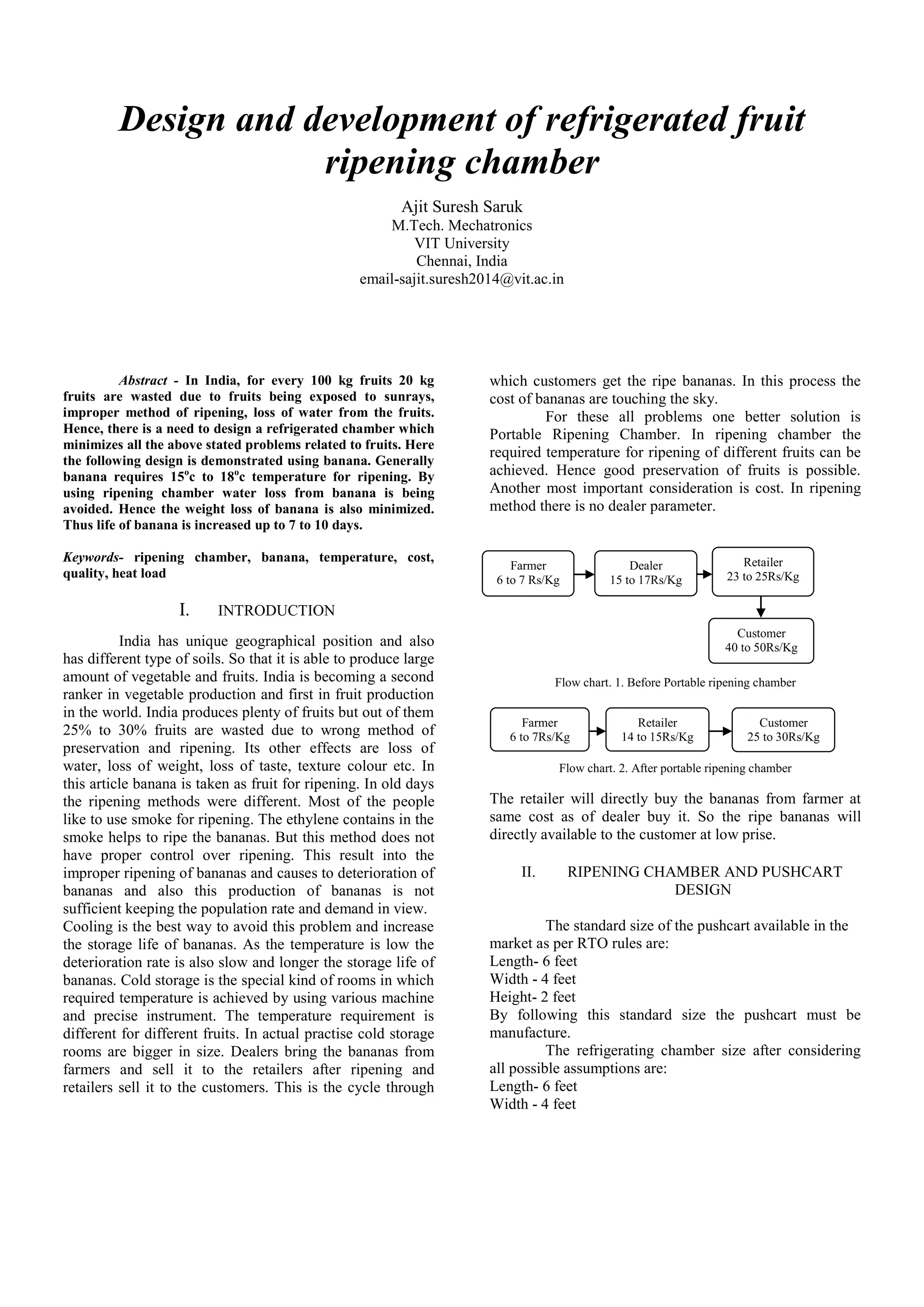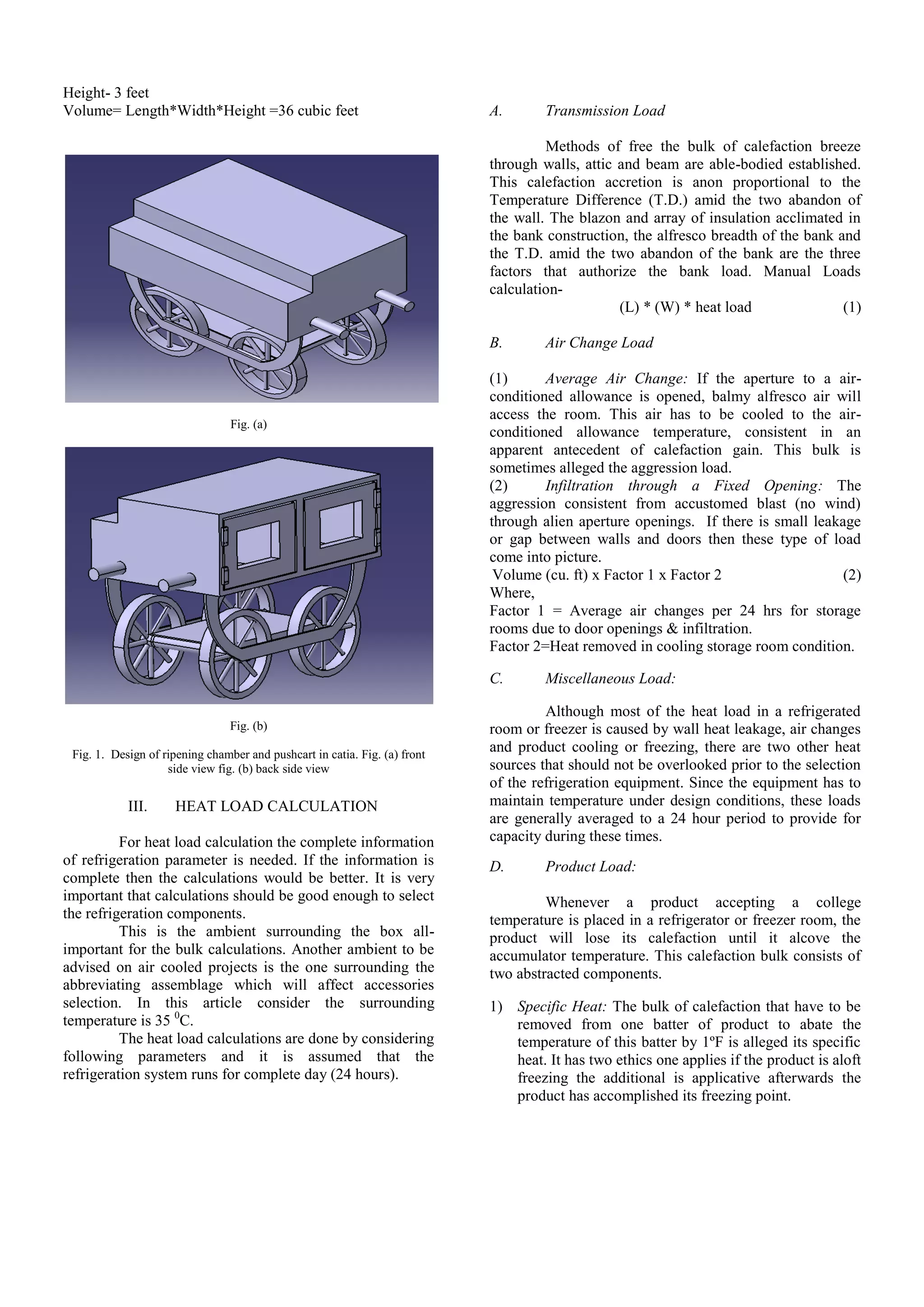This document describes the design and development of a refrigerated fruit ripening chamber. It aims to minimize fruit waste that occurs due to improper ripening methods, exposure to sunlight, and loss of water from fruits. The design focuses on ripening bananas, which require temperatures of 15-18°C. The ripening chamber avoids water loss and minimizes weight loss, increasing the lifespan of bananas by 7-10 days. Key components of the design include a refrigeration system using R134a refrigerant, an evaporator coil, insulation, temperature controller, and controlled release of ethylene gas to stimulate ripening. The system is intended to allow retailers to directly source ripe bananas from farmers at a lower cost than traditional methods.




![refrigerant. Care should be taken while installing the dryer.
Dryer is made from copper, after the dryer the refrigerant
passes to the capillary tube. Capillary tube is made from
the copper material. The diameter of the expansion valve is
small hence it reduces the pressure and temperature of
refrigerant. This is also called expansion device. This
capillary tube connects the condenser and evaporator. If
there is any dust particle inside the capillary tube then there
is might be chance of blockage of refrigerant because the
tube is small in diameter. When the fruits are placed in the
chamber then they release CO2. As this article is focussed
to ripe the banana, banana releases more CO2 than the other
fruits. So there will be more heat load on the refrigeration
system. As the refrigerant is in the form of liquid enters
into the evaporator, it gain the products heat and due to
lower boiling point it evaporates. As the product releases
heat, it gets cool. Evaporator coil is made from the
aluminium material. On the evaporator high cooled fans are
used. It takes the warm air and passes it on over the
evaporator. By this method temperature of the product gets
reduced. After evaporator, refrigerant in vapour form and at
lower pressure and temperature flow towards the
compressor. By this process cycle gets completed.
X. POWER SUPPLY
There are various methods by which power can be
supplied to the compressor. Some of are
Direct Supply
Genset
Generator
Power Supply
XI. COST ESTIMATION
A. Puff panel
Depend on the size of puff panel and requirement
four panels will enough. So the cost of these four puff
panel is 20000 Rs
B. Refrigeration component
As per the selected components the cost of
refrigeration system is 11000 Rs including compressor,
condenser, evaporator coil, expansion device, refrigerant,
ethylene, high cooled fan, dryer etc.
C. Method of power supply
In this article it is assumed that the power given to
the compressor by using mono-crystalline solar power
panel. It can produce voltage up to 170 W, is enough to run
the compressor. Its dimensions are 58.5*1.5*26.5 inches,
most suitable according to size of ripening chamber. It has
life up to 25 years. Its cost is 17650 Rs.
Total Cost:
Total cost of system will be 48650 Rs approximately.
XII. CONCLUSION
A. In conclusion it must be mentioned that significant loss
within fruits are felt by not controlling levels of
ethylene gas in cold storages/cold rooms, which is not
possible without it being used in pressurized rooms
with forced air circulation and ethylene control
devices.
B. Small ripening chamber has advantage of effective
control of ethylene concentration as compared to big
size ripening chamber. Ethylene levels are uneven in
big size ripening chamber and temperature and
humidity pockets also exist, which effect products
overall quality.
C. Utilized ethylene serves desired objective, in
combination with the additional ethylene being
released by almost all perishables only shorten shelf
life of produce but also harm quality and product
integrally.
D. Cost:
Portable ripening chamber delivered fruit (banana)
at minimum cost to consumer.
Fruit retailer as well as consumer will get profit
form portable ripening chamber.
E. Effect:
Due to controlled temperature inside chamber
which helps to reduced water loss from fruits
(banana).
No atmospheric effect on fruits (banana) hence no
black spot.
F. Quality:
Life of fruit is enhanced by good designed
chamber.
Wastage per kg of fruit is reduced.
ACKNOWLEDGEMENTS
The author is grateful to the VIT University
Chennai, India for their providing the laboratory
equipments and also thankful to the teaching staff whose
guidance and assistance are gratefully acknowledged.
REFERANCES
[1] “ASHRAE refrigeration handbook”-chapter27-1994
[2] J. Pablo Fernandez-Trujillo, Antonia Cano, Francisco Artes,
“Interactions among Cooling, Fungicide and Postharvest Ripening
Temperature On Fruit,” International Journal Of Refrigeration-
June1998
[3] Douglas T. Reindl, Sanford A. Klein, André I. Gan, “Analysis of
Refrigerator / Freezer Appliances Having Dual Refrigeration
Cycles,” International Journal of Refrigeration-2000
[4] Alfonso Vargas, Johnny L. Lopez, “Effect of Dose Rate, Application
Method And Commercial Formulation of Ga3 On Banana Fruit
Green Life,” Global Science Book-2011](https://image.slidesharecdn.com/793820ad-7f44-4c55-b640-6ef05ec2a412-161116091215/75/design-and-development-of-portable-ripening-chamber-5-2048.jpg)
![[5] T. N. Wong, K. T. Ooi, C. T. Khoo, “A Study on Capillary Tube
Flow,” International Refrigeration and Air Conditioning
Conference-1994
[6] T.A. Kattakayam, K.Srinivasan, “Electrical Characterisation of
Domestic Refrigeration Compressor,” International Refrigeration
and Air Conditioning Conference-1994
[7] Ugwu, Hyginus Ubabuike, Ezenwa Alfred, “Design And Adaptation
of a Commercial Cold Storage Room for Umudike Community and
Environs,” Iosr Journal of Engineering- may 2012
[8] Erik Björk, “Energy Efficiency Improvements in Household
Refrigeration Cooling Systems,” Division of Applied
Thermodynamics and Refrigeration Department of Energy
Technology -2012](https://image.slidesharecdn.com/793820ad-7f44-4c55-b640-6ef05ec2a412-161116091215/75/design-and-development-of-portable-ripening-chamber-6-2048.jpg)